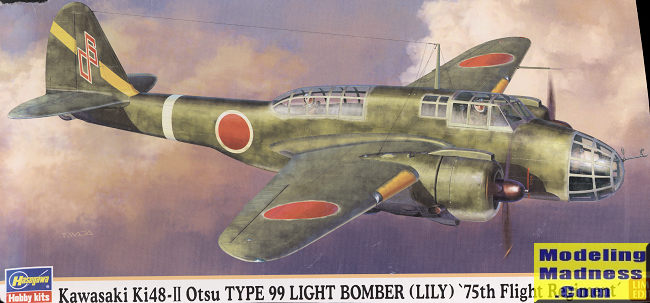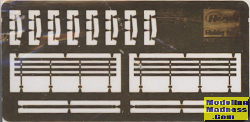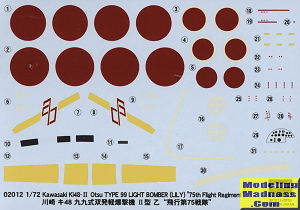
Hasegawa 1/72 Ki-48-II (Lily) '75th Flight Regiment'
| KIT #: | 02012 |
| PRICE: | 2600 yen |
| DECALS: | One option |
| REVIEWER: | Scott Van Aken |
| NOTES: | 2012 Limited edition |

| HISTORY |
The development of the aircraft began at the end of 1937 at the request of the Japanese military high command. Kawasaki received an order to develop a "high-speed bomber" capable of 480 km/h (300 mph) at 3,000 m (9,840 ft), and able to reach 5,000 m (16,400 ft) within 10 minutes. It was inspired by the Soviet Tupolev SB.
Kawasaki had the advantage of the experience of designing the Ki-45 twin-engined heavy fighter. Most technical problems were solved; however the aircraft had a number of shortcomings. It carried only an 800 kg (1,760 lb) bombload. This was actually more than contemporary light bombers such as the Bristol Blenheim or Tupolev SB, and only slightly less than light bombers designed several years later, such as the A-20 Havoc, and the strikingly similar-appearing Martin Maryland and Baltimore. Speed was intended to be its primary defense, much like the later, unarmed, De Havilland Mosquito. So it had only three machine guns (again, an equivalent armament to contemporary light bombers). This made it very vulnerable to enemy fighters later in the war, once they became fast enough to actually catch it. The flight characteristics of the Ki-48 also left something to be desired. Newer generations of Allied fighters caught up in speed, and eventually, the Ki-48 was too slow to outrun them, while superior modern Japanese aircraft, such as the Yokosuka P1Y and the Mitsubishi Ki-67, could only be produced in small numbers. The first versions were lightly armoured, so the Ki-48 was quite aerobatic, and could loop and turn with an experienced pilot at the controls. The aircraft was often used as a dive bomber in Burma. The aircraft was not necessarily a failure, and was considered an acceptable light bomber for the first few years of the war by many historians. Much like the Mitsubishi A6M Zero fighter, it was satisfactory for the period when it was designed and produced, but had to be used against much newer and faster competition, due to Japan's inability to produce enough newer aircraft.
| THE KIT |
 This
particular kit was purchased in a bag. As many of you are aware, the Ki-48 is
one of many kits that were initially tooled by Mania and entered the Hasegawa
line when they bought the company. Though the kits do show that they are from
the early 70s, the nicely done engraved surface detail makes them seem more
modern.
This
particular kit was purchased in a bag. As many of you are aware, the Ki-48 is
one of many kits that were initially tooled by Mania and entered the Hasegawa
line when they bought the company. Though the kits do show that they are from
the early 70s, the nicely done engraved surface detail makes them seem more
modern.
You get a nicely done interior for the scale that includes a lot of interior detail like O2 bottles and radios, though some items like the seats are fairly generic. You are also provided with a decal for the instrument panel. No crew is provided as Mania did not offer these. This variant was armed with a machine gun for the rear upper and lower fuselage. Since the greenhouse for the upper rear is a single piece, you'll have to model that one stowed, though you can pose the lower dropdown open, though most will not.
 You do have to open some holes in the kit,
but the instructions show you just what you need to do. Engine cowlings are two
side panels with a single cowling front so no worries about seams. Landing gear
is nicely done and can be installed after everything is painted. I would highly
recommend that you obtain a set of canopy masks for this as there are many panes
to mask. The kit also comes with a set of photo etched dive brakes for use on
the box art option and that of the third markings option.
You do have to open some holes in the kit,
but the instructions show you just what you need to do. Engine cowlings are two
side panels with a single cowling front so no worries about seams. Landing gear
is nicely done and can be installed after everything is painted. I would highly
recommend that you obtain a set of canopy masks for this as there are many panes
to mask. The kit also comes with a set of photo etched dive brakes for use on
the box art option and that of the third markings option.
 Instructions
are standard Hasegawa fare with three options. All of them start with a baseline
color of green-grey. The box art plane with the 75th based in the Dutch East
Indies during 1944 has the upper surface heavily oversprayed with Kawasaki
dark green. Note the the greenhouse surrounds are not oversprayed. The second
option is also with the 75th and based in Malaya. This one has the upper surface
covered with a variegated camouflage, in what is listed as Nakajima dark green.
The third is in overall green-grey with the Hokota Flying School and used
to test dive bombing. Decals are nicely printed, though the white bits are
more of an off-white than a pure white.
Instructions
are standard Hasegawa fare with three options. All of them start with a baseline
color of green-grey. The box art plane with the 75th based in the Dutch East
Indies during 1944 has the upper surface heavily oversprayed with Kawasaki
dark green. Note the the greenhouse surrounds are not oversprayed. The second
option is also with the 75th and based in Malaya. This one has the upper surface
covered with a variegated camouflage, in what is listed as Nakajima dark green.
The third is in overall green-grey with the Hokota Flying School and used
to test dive bombing. Decals are nicely printed, though the white bits are
more of an off-white than a pure white.
| CONCLUSIONS |
I have built this kit in the past, though with different markings. It is a fairly good build, but you do need to be careful during assembly as it isn't a 'shake and bake' kit by any means. Still, it is one that most modelers will be able to handle without any real issues.
| REFERENCES |
https://en.wikipedia.org/wiki/Kawasaki_Ki-48
April 2021 Copyright ModelingMadness.com.
All rights reserved. If you would like your product reviewed fairly and
fairly quickly, please
contact
the editor
or see other details in the
Note to
Contributors.
Back to the Main Page
Back to the Review
Index Page
Back to the Previews Index Page